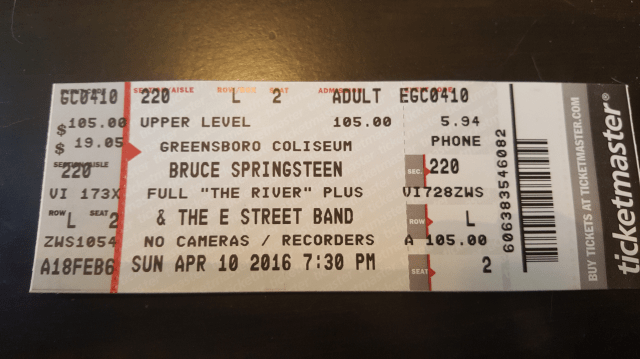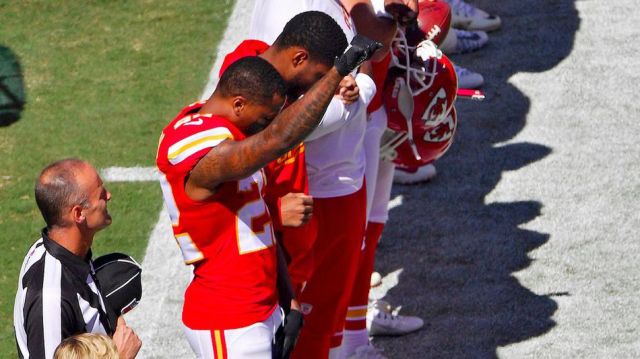It’s funny the things that will come up when you’re in the process of moving. During me and my wife’s latest move from the foothills of North Carolina to the Gulf Coast of Florida, I happened across probably one of the more disappointing moments from this year (at least until possibly the election in November)…

Now, the seats weren’t fantastic – in fact, they were at the other end of the arena from where the stage was situated. But they were square on with the stage and would have offered a great opportunity to see much of the crowd enjoying the show from Bruce, one of the legendary performers in rock history (I could tell stories about seeing him in 1980 for a six-plus hour show, but we’ll save that for another time). My wife and I were eagerly anticipating the show as it had been many years since either of us had been able to see “The Boss” in action.
Then the North Carolina General Assembly and asswipe Governor Pat McCrory got their panties in a bunch.
In February, the Charlotte City Council passed an ordinance extending protections to the lesbian/bisexual/gay/transgender (LGBT) community. A part of this ordinance – and the issue that sparked the most controversy – was the provision for allowing people to use the restroom of their gender identity, rather than that of whichever sex they were born. In essence, the ordinance allowed those who were in the process of shifting from one sex to another to use the restroom of that other sex (male transgendered individuals could use female restrooms and vice versa).
The response by McCrory and the GOP-dominated North Carolina legislature (which has been gerrymandered to make it virtually impossible for a balanced legislature to occur – witness the THREE TIMES that the federal government has called the state’s legislative districts unconstitutional) was immediate. Convening a special session of the General Assembly (one outside the normal working times of the legislative body), McCrory and his henchmen pushed through HB2, a bill that was so overreaching in its aim it was destined for the “unconstitutional” bin almost from the start.
Not only did that bill immediately set that “all people” had to use the restroom of the birth sex, but it also removed the right for minorities and the LGBT community to sue through the state court system for discrimination. It included a provision that prevented individual cities from enacting their own laws that differentiated from state statutes. With many Democratic representatives protesting by leaving the voting floor, the statute passed through the General Assembly with only about 12 HOURS of overall discussion.
This was the end of March and, within days, the impact was felt. Several local productions in theaters around the Tar Heel State reported that the rights holders to significant stage productions (plays) were pulling their approval for performance over the bill. The streaming provider Hulu pulled the production of a program they had set for airing out of North Carolina over the bill and PayPal suspended expansion of its operations center in the state. This was but the tip of the iceberg, however.

Many entertainment artists have also pulled out of shows that they were scheduled to perform, including “The Boss,” Pearl Jam, Boston, Bryan Adams, Ani DiFranco, Ringo Starr, Nick Jonas and Demi Lovato and Cirque du Soleil. The real thunder came down, however, over the past couple of months, first with the National Basketball Association’s removal of the 2017 NBA All-Star Game from Charlotte. Then, just yesterday, the National Collegiate Athletics Association (NCAA) removed SEVEN championship games or playoff sites from the state, citing the law as the reason. All totaled, the loss of business regarding all of these repercussions could total to as much as half a billion dollars by the year anniversary of HB2’s passage, with the NBA All-Star Game accounting for about $100 million of that total, and could even impact future business in the state.
The reason this came back to me was not only a result of the move. Finding that ticket stub for an unused concert was simply the catalyst for a reply to model Kate Upton’s Twitter hissy fit over athletes not standing for the National Anthem. Of course, over the weekend was the opening weekend of the National Football League season (and the 15th anniversary of 9/11, just coincidentally) and, following in the footsteps of San Francisco 49ers quarterback Colin Kaepernick’s continuing protest against inequality in the United States, some players either did not stand for, knelt in protest or displayed the “Black Power” salute as the National Anthem played. This bunched Upton’s panties, who stated, “This is unacceptable. You should be proud to be an American. Especially on 9/11 when we should support each other.”
The continued attention being drawn to what has now become a movement (hey, if a subject catches the nation’s attention for more than two years – yes, it’s been that long since the death of Michael Brown in Ferguson, widely considered the spur – it is a movement) is only done when a protest has an impact. Kaepernick has been vocal in the past regarding the issues of black people in the United States and their treatment at the hands of law enforcement, but no one was paying any attention to what he was saying. It wasn’t until his act of defiance of not standing for the National Anthem – and attention was drawn to the fact that he was doing it – that there became a national conversation (admittedly sometimes not about what Kaepernick wanted to talk about, as with Upton’s attempt at using her First Amendment rights by silencing Kaepernick’s, but still there was discussion).

For a protest to have an impact, there are a couple of things that it should have. It has to have some financial teeth, some fiscal bite, that pushes some to reconsider their positions (it also has to have a side that understands those fiscal implications – apparently North Carolina Republicans are morons if they issue this response). Along with that, it should have some emotional impact on people. There were plenty that were upset over Springsteen’s decision to not perform in North Carolina, just as there are more than likely many upset that Demi Lovato didn’t come to North Carolina or that LeBron James won’t be making an appearance during the NBA All-Star Game in the state. A protest only works when it hurts, either physically or emotionally. That is what makes a protest enact the change that comes about (eventually) with issues.
I’m putting those unused Bruce Springsteen tickets back in the desk as a reminder to myself for a couple of reasons. One, something has to be lost (in some cases) for a protest to have its desired effect, and Two, there is the ability to protest at all levels, from the richest of us all to the poorest. It will be some time before the protests of the actions in North Carolina and the national discussion of inequality are adequately addressed, but hopefully it is sooner than later.






